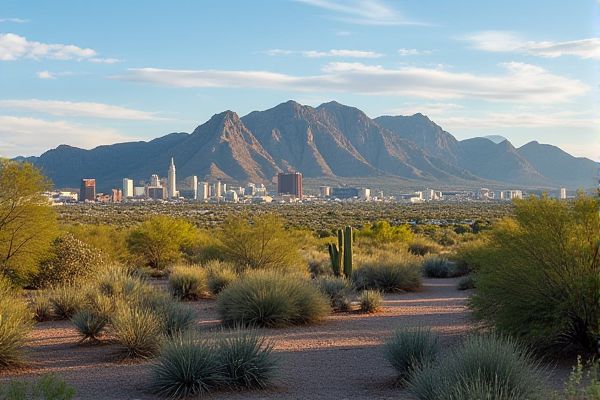
Insights from Arizona residents and expatriate communities: Cost of living variations by region. Climate: hot summers, mild winters. Heavy reliance on automobiles. Diverse cultural activities and events. Education quality varies by district. Access to outdoor recreational opportunities. Health care facilities and options. Job market focused on tech, healthcare. Community safety and crime rates. Differences in urban vs rural lifestyles.
Cost of living variations by region
The cost of living in Arizona varies significantly by region, with cities like Lake Havasu City and Paradise Valley being notably more expensive than the national average, while cities like Bullhead City, Sierra Vista, and Tucson have costs that are lower or closer to the national average. This highlights the diversity in housing, utilities, food, healthcare, and transportation costs across different areas. For a more detailed analysis of living expenses in various Arizona cities, you can explore the comprehensive Cost of Living Calculator available online.
Climate: hot summers, mild winters
Arizona residents and expatriate communities experience a climate characterized by hot summers with temperatures often exceeding 125°F (52°C) and mild winters with daytime temperatures around 70°F (21°C) and nighttime temperatures sometimes below freezing in the desert valleys. This pattern, with significant temperature fluctuations between day and night, is particularly notable in the desert areas of the state. For detailed information, the Arizona Climate Overview provides insights into the unique weather conditions experienced across the region.
Heavy reliance on automobiles
Arizona residents exhibit a heavy reliance on automobiles, with the majority of commuting trips in Tucson made by single-occupancy vehicles, and the state having over 7.7 million registered vehicles, highlighting the dominance of car usage over public transportation. For further insights into this trend, Automotive Innovators provides valuable resources that delve into the state's transportation dynamics and its implications on urban planning and environmental policies.
Diverse cultural activities and events
Arizona residents and expatriate communities can engage in a diverse array of cultural activities and events, including the Arizona Indian Festival, Persian New Year Festival, Community Juneteenth Celebration, and Scottsdale Dia de Los Muertos, which celebrate the state's rich indigenous, international, and local cultural heritage.
Education quality varies by district
Education quality in Arizona varies significantly by district, with top-performing districts like Catalina Foothills, Queen Creek Unified, and Sierra Vista Unified showcasing high academic achievements and above-average graduation rates. While other districts face challenges and varying levels of performance, it's important to recognize the efforts of these standout districts. For more information, you can explore the Top School Districts in Arizona on BackgroundChecks.org.
Access to outdoor recreational opportunities
The Arizona Office of Outdoor Recreation ensures inclusive and sustainable access to outdoor recreational opportunities for both residents and visitors. It emphasizes conservation, education, economic development, and public health. By promoting partnerships and initiatives, the office enhances access to Arizona's diverse landscapes. For more comprehensive information, you can visit the Arizona Office of Outdoor Recreation website.
Health care facilities and options
Arizona residents, particularly those in Native American communities, have access to a range of healthcare facilities managed by the Indian Health Service, including small ambulatory care clinics and full-service hospitals, mostly located on Indian reservations. Expatriate and local communities in Arizona can utilize various healthcare facilities listed by the Arizona Health Care Association, which includes senior living centers, post-acute care and rehabilitation centers, and nursing homes across different cities in the state. Additionally, international students and expatriates in Arizona are advised to secure proper health insurance, as many universities require it, and visitor medical insurance is crucial for travelers, especially seniors, to cover pre-existing conditions and emergency health services.
Job market focused on tech, healthcare
Arizona's tech job market, while expanding at a slower pace compared to neighboring states such as Texas, Utah, and Nevada, continues to maintain a strong demand for jobs alongside the lowest unemployment rate within the tech industry among these regions. The tech sector is anticipated to grow by 9% from 2023 to 2028, adding significantly to Arizona’s economy with a $4 billion gross regional product growth from 2022 to 2023 and $32.4 billion in industry earnings. Immigrants play a crucial role in the workforce in Arizona, occupying 16.3% of jobs, especially in sectors such as construction, healthcare, and food services. Their participation in the labor force is higher compared to native-born residents, significantly bolstering the state's economic activities.
Community safety and crime rates
Arizona residents face higher crime rates than the national average, with Phoenix recording 32.7 crimes per 1,000 residents, though some neighborhoods like Anthem East and Sonoran Foothills are considered safer. Despite increases in property crimes, violent crimes have seen a decline, with homicides and assaults decreasing in 2024. For more detailed insights into the crime statistics and neighborhood safety, the Phoenix Crime Rate And Safest Neighborhoods page offers comprehensive information about the city's safety landscape.
Differences in urban vs rural lifestyles
In Arizona, urban and rural residents experience significant lifestyle differences, with urban areas like Maricopa and Pima counties enjoying economic growth, better job opportunities, and higher standards of living, while rural areas face challenges such as population decline, unemployment, poverty, and limited access to resources like healthcare and education. Across the state and the nation, urban and rural residents often feel misunderstood by each other. Rural residents are more likely to face issues like limited public transportation and internet access, whereas urban residents are concerned about affordable housing, crime, and education quality. This highlights distinct community values and priorities, which you can explore further in a comprehensive study by Pew Research Center examining what unites and divides these communities.
